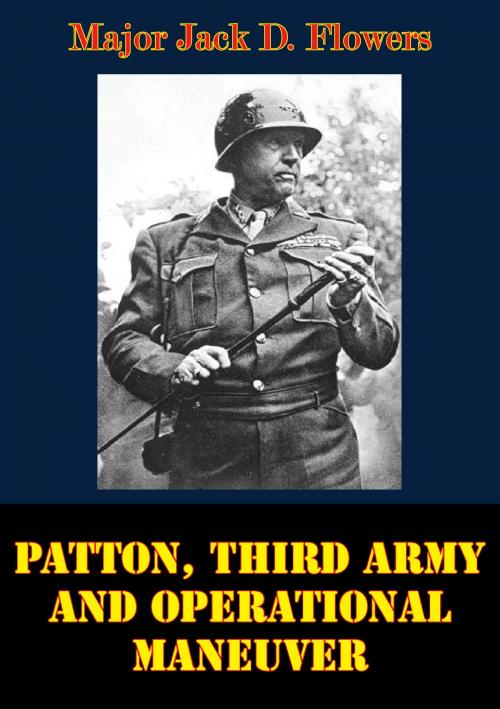Patton, Third Army And Operational Maneuver
Nonfiction, History, Germany, European General, Military, United States| Author: | Major Jack D. Flowers | ISBN: | 9781786253194 |
| Publisher: | Lucknow Books | Publication: | November 6, 2015 |
| Imprint: | Lucknow Books | Language: | English |
| Author: | Major Jack D. Flowers |
| ISBN: | 9781786253194 |
| Publisher: | Lucknow Books |
| Publication: | November 6, 2015 |
| Imprint: | Lucknow Books |
| Language: | English |
On 16 December 1944, the German Army launched an offensive in the Ardennes to split Allied forces and retake the ports of Antwerp and Liege. The German advance split the XII Army forces and left the 101st Airborne Division surrounded at Bastogne. To relieve the encircled units in the Ardennes and defeat the German offensive, Third Army conducted an impressive counterattack into the flank of the Germans. The flexibility to turn ninety degrees during the worst winter in thirty-eight years and relieve the encircled forces stands out as one of the greatest operational maneuvers in history. While this operation is unique, the actions of the commander and staff that planned and executed it deserve closer analysis to determine what enabled them to orchestrate this maneuver. It is especially remarkable, when taken in context, how rapidly the Army changed during the previous four years.
The US Army anticipating eventual war in Europe began a transformation which included drastic changes in force structure and doctrine. The primary transformation in doctrine was the revision of Field Service Regulation 100-5. The 1941 edition of 100-5 superseded a tentative version published in 1939 which was the first major revision of warfighting doctrine since 1923. It was with this manual that the Army went to war. It was also the manual used to train and teach new and reserve officers who had little experience in the study and practice of war. How important and to what extent did Patton’s Third Army apply the doctrine in conducting the Battle of the Bulge?
Particularly relevant to serving officers today is to analyze the operations of Third Army in terms of doctrine that existed in 1944 and today’s current doctrine. An examination of similarities and differences between the doctrines may allow development of possible conclusions on the ability of future forces to conduct decisive maneuver in compressed time and space.
On 16 December 1944, the German Army launched an offensive in the Ardennes to split Allied forces and retake the ports of Antwerp and Liege. The German advance split the XII Army forces and left the 101st Airborne Division surrounded at Bastogne. To relieve the encircled units in the Ardennes and defeat the German offensive, Third Army conducted an impressive counterattack into the flank of the Germans. The flexibility to turn ninety degrees during the worst winter in thirty-eight years and relieve the encircled forces stands out as one of the greatest operational maneuvers in history. While this operation is unique, the actions of the commander and staff that planned and executed it deserve closer analysis to determine what enabled them to orchestrate this maneuver. It is especially remarkable, when taken in context, how rapidly the Army changed during the previous four years.
The US Army anticipating eventual war in Europe began a transformation which included drastic changes in force structure and doctrine. The primary transformation in doctrine was the revision of Field Service Regulation 100-5. The 1941 edition of 100-5 superseded a tentative version published in 1939 which was the first major revision of warfighting doctrine since 1923. It was with this manual that the Army went to war. It was also the manual used to train and teach new and reserve officers who had little experience in the study and practice of war. How important and to what extent did Patton’s Third Army apply the doctrine in conducting the Battle of the Bulge?
Particularly relevant to serving officers today is to analyze the operations of Third Army in terms of doctrine that existed in 1944 and today’s current doctrine. An examination of similarities and differences between the doctrines may allow development of possible conclusions on the ability of future forces to conduct decisive maneuver in compressed time and space.


![Cover of the book Road To Huertgen: Forest In Hell [Illustrated Edition] by Major Jack D. Flowers](https://www.kuoky.com/images/2014/august/300x300/9781782898467-CKj5_300x.jpg)





![Cover of the book In The Northern Mists; A Grand Fleet Chaplain’s Note Book [Illustrated Edition] by Major Jack D. Flowers](https://www.kuoky.com/images/2015/november/300x300/9781786255365-e12R_300x.jpg)

![Cover of the book The Mediterranean And Middle East: Volume II The Germans Come To The Help Of Their Ally (1941) [Illustrated Edition] by Major Jack D. Flowers](https://www.kuoky.com/images/2014/august/300x300/9781782896227-i80K_300x.jpg)




